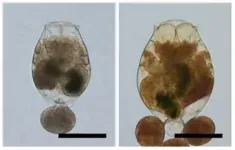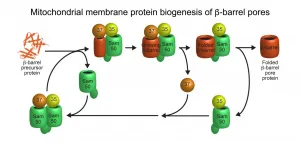Filling a crucial gap in aquafarming: ion beam breeding to the rescue
2021-01-15
(Press-News.org) A research team led by scientists at the RIKEN Nishina Center for Accelerator-Based Science (RNC) has successfully created larger-than-usual strains of zooplankton -- which are used in fish nurseries -- by creating mutations with a heavy ion beam. The new strains of zooplankton could contribute to improving the survival rate and optimizing the growth of juvenile fish in aquaculture.
Economically important fish species, such as bluefin tuna, yellowtail, flatfish and groupers, are fed live bait until they are large enough to be fed with artificial foods. Rotifers, a type of animal plankton, are commonly used as the initial live food. However, fish need progressively larger bait as they grow, but rotifers are generally small and often not large enough to satisfy the growing fish, leading to cannibalism or growth abnormalities and eventually lowering the survival rate. "We decided to try to do something to improve the survival rate of fish larvae, as this would help to increase aquaculture productivity. We thought that if we could create a large rotifer strain using our expertise, it would contribute to stabilizing the income for aquafarmers," says Tomoko Abe from RIKEN RNC, who led the study, published in Bioscience, Biotechnology, and Biochemistry.
In collaboration with the Japan Fisheries Research and Education Agency and Nagasaki University, the research team began experimenting using a technique known as heavy ion beam irradiation in an attempt to create larger rotifers. Heavy ion breeding is a technique where cells are exposed to a beam of heavy atomic nuclei, creating mutations much more effectively than natural processes such as UV light. By adjusting the type of ion and dose, the beam is used to induce random mutations in the genome, and strains with desirable phenotypes can be selected. The team has already succeeded in developing highly effective mutant lines of oil-producing microalgae, high-yielding rice, and a commercialized sake yeast, using similar techniques.
Using the RIKEN RI Beam Factory (RIBF) the team irradiated proliferating rotifers with beams of argon and carbon ions. They then selected larger individuals and cultured the plankton for several generations to create a large mutant line. The bred rotifers were approximately 1.2 times larger than other strains, which the group judged would be an ideal size for growing juvenile fish. They also found that some of the strains were not only larger, but also grew more quickly than the parent strains. "In general, larger mutants grow more slowly than normal rotifers, but we were lucky to discover a line that grows not only larger but faster as well," Abe recalls. "However, picking a large mutant among live rotifers that are moving quickly around under a microscope was far more difficult than we had anticipated and actually was the hardest part of this study."
Food shortages due to population growth and increased consumption are a major global concern, and countries around the world are looking for ways to increase food production. Resources from the ocean, which occupies 70 percent of the Earth's surface area, can be an effective and promising solution to the problem. For Japan in particular, as an island nation with a large exclusive economic zone, increasing the production of marine resources is an attractive goal. The enlarged rotifers obtained in this study could potentially provide a stable supply of larger rotifers at low cost, enhancing aquaculture. Moving forward, the group now plans to use the larger rotifers in field tests to see if they can demonstrate improved survival.
INFORMATION:
[Attachments] See images for this press release:

ELSE PRESS RELEASES FROM THIS DATE:
2021-01-15
Any building project requires the formulation of a series of initial plans prior to starting construction to serve as a basis and guide for the whole process. A similar procedure is followed in software development, with the inclusion of a specific step known as modelling. "The process is equivalent to the production of a set of plans for a building before its construction," explained Universitat Oberta de Catalunya (UOC) Faculty of Computer Science, Multimedia and Telecommunications professor and member of the SOM Research Lab research group -from the Internet Interdisciplinary Institute (IN3)-, Robert Clarisó.
Engineers use modelling to describe ...
2021-01-15
In the last decades, Artificial Intelligence has shown to be very good at achieving exceptional goals in several fields. Chess is one of them: in 1996, for the first time, the computer Deep Blue beat a human player, chess champion Garry Kasparov. A new piece of research shows now that the brain strategy for storing memories may lead to imperfect memories, but in turn, allows it to store more memories, and with less hassle than AI. The new study, carried out by SISSA scientists in collaboration with Kavli Institute for Systems Neuroscience & Centre for Neural Computation, Trondheim, Norway, has just been published in Physical Review Letters.
Neural networks, real or artificial, learn by tweaking the connections ...
2021-01-15
An innovative new study is set to examine if changing our mealtimes to earlier or later in the day could reduce the risk of developing Type 2 diabetes.
Led by Dr Denise Robertson, Professor Jonathan Johnston and post graduate researcher Shantel Lynch from the University of Surrey, the study, outlined in the journal Nutrition Bulletin, will investigate if changing the time we eat during the day could reduce risk factors such as obesity and cholesterol levels that are typically associated with the development of Type 2 diabetes. The team of researchers will also for the first time investigate, via a series of interviews with participants and their friends and family, the impact of such changes on home life, work/social commitments and whether co-habitants of those who make such ...
2021-01-15
Having genitals of a certain shape and size gives male flies a major reproductive advantage, new research shows.
University of Exeter scientists examined the reproductive success of male Drosophila simulans flies both alone with a female and in various states of competition with other males.
Certain genital shapes were consistently better in terms of number of offspring sired.
However - surprisingly, given how fast genital form evolves - the selection documented was rather weak.
"Male genitals generally, and in Drosophila specifically, evolve very quickly, so we were really surprised to find this weak selection," said Professor David Hosken, of the University of Exeter.
"Selection is the major mechanism of evolution and hence where we see rapid evolution, ...
2021-01-15
Mitochondria are vital for the human body as cellular powerhouses: They possess more than 1,000 different proteins, required for many central metabolic pathways. Disfunction of these lead to severe diseases, especially of the nervous system and the heart. In order to transport proteins and metabolites, mitochondria contain a special group of so-called beta-barrel membrane proteins, which form transport pores in the outer mitochondrial membrane. So far, scientists have not been able to explain the operating mode of the sorting and assembly machinery (SAM) for the biogenesis of these beta-barrel proteins. A team led by Prof. Dr. Toshiya Endo from Kyoto University/Japan, Prof. Dr. Nils Wiedemann and ...
2021-01-15
Guangzhou, January 15, 2021: New journal BIO Integration (BIOI) publishes its fourth issue, volume 1, issue 4. BIOI is a peer-reviewed, open access, international journal, which is dedicated to spreading multidisciplinary views driving the advancement of modern medicine. Aimed at bridging the gap between the laboratory, clinic, and biotechnology industries, it will offer a cross-disciplinary platform devoted to communicating advances in the biomedical research field and offering insights into different areas of life science, in order to encourage cooperation and exchange among scientists, clinical researchers, and health care providers.
The issue contains an original article, three review ...
2021-01-15
A clinical trial involving COVID-19 patients hospitalized at UT Health San Antonio and University Health, among roughly 100 sites globally, found that a combination of the drugs baricitinib and remdesivir reduced time to recovery, according to results published Dec. 11 in the New England Journal of Medicine. Six researchers from UT Health San Antonio and University Health are coauthors of the publication because of the San Antonio site's sizable patient enrollment in the trial.
The Adaptive COVID-19 Treatment Trial 2 (ACTT-2), which compared the combination therapy versus remdesivir paired with an inactive placebo in hospitalized COVID-19 patients, was supported by the National Institute of Allergy and Infectious Diseases (NIAID), ...
2021-01-15
Certain snakes have evolved a unique genetic trick to avoid being eaten by venomous snakes, according to University of Queensland research.
Associate Professor Bryan Fry from UQ's Toxin Evolution Lab said the technique worked in a manner similar to the way two sides of a magnet repel each other.
"The target of snake venom neurotoxins is a strongly negatively charged nerve receptor," Dr Fry said.
"This has caused neurotoxins to evolve with positively charged surfaces, thereby guiding them to the neurological target to produce paralysis.
"But some snakes have evolved to replace a negatively charged amino acid on their receptor with a positively charged one, meaning the neurotoxin is repelled.
"It's an inventive genetic mutation and it's been completely missed until now.
"We've ...
2021-01-15
PHILADELPHIA - Our biological or circadian clock synchronizes all our bodily processes to the natural rhythms of light and dark. It's no wonder then that disrupting the clock can wreak havoc on our body. In fact, studies have shown that when circadian rhythms are disturbed through sleep deprivation, jet lag, or shift work, there is an increased incidence of some cancers including prostate cancer, which is the second leading cause of cancer death for men in the U.S. With an urgent need to develop novel therapeutic targets for prostate cancer, researchers at the Sidney Kimmel Cancer - ...
2021-01-15
Oxygen levels in the ancient oceans were surprisingly resilient to climate change, new research suggests.
Scientists used geological samples to estimate ocean oxygen during a period of global warming 56 million years ago - and found "limited expansion" of seafloor anoxia (absence of oxygen).
Global warming - both past and present - depletes ocean oxygen, but the new study suggests warming of 5°C in the Paleocene Eocene Thermal Maximum (PETM) led to anoxia covering no more than 2% of the global seafloor.
However, conditions are different today to the PETM - today's rate of carbon emissions is much faster, and we are adding nutrient pollution to the oceans - both of which could drive more rapid and expansive oxygen loss.
The study was carried out by an international ...
LAST 30 PRESS RELEASES:
[Press-News.org] Filling a crucial gap in aquafarming: ion beam breeding to the rescue



